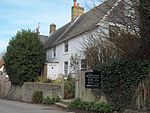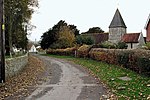Rodmell

Rodmell is a small village and civil parish in the Lewes District of East Sussex, England. It is located three miles (4.8 km) south-west of Lewes, on the Lewes to Newhaven road and six and a half miles from the City of Brighton & Hove and is situated by the west banks of the River Ouse. The village is served by Southease railway station, opened in 1906. The Prime Meridian passes just to the west of the village. The village name has been variously spelled as Ramelle or Redmelle (11th century), Redmelde (12th century), Radmelde (13th century) and Radmill (18th century). It most likely derives from Brittonic where Rhod denotes a wheel and Melin refers to a Mill, hence mill wheel. A less likely derivation is from Old English read *mylde, "[place with] red soil". Before the time of the Norman conquest the manor of Rodmell was held by King Harold II. At the time the Domesday Book was compiled, there was a church in Rodmell, which was granted to Lewes Priory by William de Warenne, 2nd Earl of Surrey. The early Norman church is dedicated to St. Peter. The font is believed to be Saxon, predating the building itself. More recently, Monk's House was the home of the author Virginia Woolf for twenty-one years until her death in 1941. The village is bisected by the road from Lewes to Newhaven which passes through Iford. This road also passes the neighbouring village of Southease. The village was part of the Holmstrow hundred until the abolition of hundreds in the 19th century.
Excerpt from the Wikipedia article Rodmell (License: CC BY-SA 3.0, Authors, Images).Rodmell
The Street,
Geographical coordinates (GPS) Address Nearby Places Show on map
Geographical coordinates (GPS)
| Latitude | Longitude |
|---|---|
| N 50.83581 ° | E 0.0134 ° |
Address
The Street
The Street
BN7 3HE , Rodmell
England, United Kingdom
Open on Google Maps










